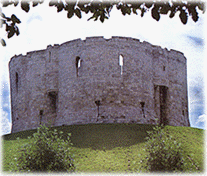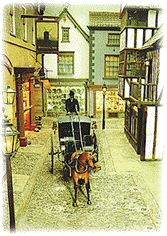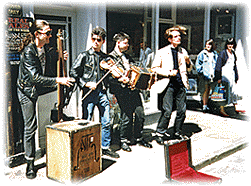
‘York is too good to be true’ wrote H V Morton in 1927 (In Search of England). ‘If you are interested in old things, in beautiful things, and in the history of this country, there is one city which will exceed your expectation - York’.
‘The history of York is the history of England’. It was a good line of King George VI, not one usually remembered for his soundbites. Indeed, York is steeped in history.
York, Eboracum, was the Romans’ capital of Lower Britain. In the year 306 the Emperor Constantius Chlorus died in York and his son, who was with him and who became Constantine the Great, the first Christian Emperor of Rome, was proclaimed Emperor there. York became the Anglo-Saxon Eoferwic and as Jorvik it developed as a Viking trading centre. In medieval times York, centred on the Minster, prospered. The walls were built. The gilds were established.
During the Wars of the Roses the forces of Edward IV met the Lancastrians at Towton, ten miles south-west of York, on Palm Sunday 1461. They fought all day hand to hand in the snow. It is thought that as many as 28,000 young men died, the bloodiest battle on English soil.

Clifford's Tower
In July 1644 during the Civil Wars, the forces of Parliament met the Royalists at Marston Moor, six miles west of York. Both sides faced each other but neither attacked. Late in the day the weather worsened, the Royalists relaxed and, unexpectedly, the Roundheads, led by Fairfax, attacked. Among the six thousand dead and mortally wounded were some of the Royalists finest troops. As always, young men.
In the eighteenth century York was the social capital of the North of England. During the Industrial Revolution the city became a railway centre and a major manufacturer of confectionery (Kit-Kat, Aero, Polo mints, for example). The Victorians added some fine buildings to those which they inherited from earlier generations.
So York has some justification to claim the status of England’s second city. (Birmingham makes the same claim. Having worked in Birmingham for four years, I can think of a number of criteria by which it would be ranked first or second. None is flattering. My enduring memory of Birmingham is concrete dripping in the rain). Today Manchester and Leeds are the commercial centres of the North of England but York is its spiritual capital.
York Minster
Gillygate, Coppergate, Fossgate, Shambles reads like a children’s chant. York still has its medieval street pattern. Some sixty churches, museums and historic buildings are within the city walls. The walls date mainly from the 14th century (and are, of course, much restored). The gates are at Bootham Bar, Micklegate Bar, Monk’s Bar and Walmgate Bar. One can walk around two and a half miles of the wall, the view within dominated by the Minster. The Shambles show what medieval York was like: it is a narrow street above which the houses crane forward above what were once butchers’ shops beneath.
York Minster is our largest Gothic cathedral. It is quite incredible that such a building could be constructed with medieval technology. But then, of course, these are the people who walked to Jerusalem, fought the Infidel, and walked back. Who walked to Agincourt, where they were hopelessly outnumbered by the French, beat them and walked home. York Minster is simply magnificent. It is said to contain half the medieval stained glass in England. It has been restored and underpinned in the twentieth century. The work which was carried out to repair the damage caused by a fire which resulted from a lightning strike in 1984 shows that we still have the skills today even though we rarely use them.

A York Street Name
Other significant buildings include the Merchant Adventurers’ Hall, a medieval guildhall built in the 14th century, Fairfax House, a restored 18th century town house, the 15th century Guildhall itself and the Mansion House, completed in 1730, the official home of the Lord Mayor.
For those who like their history packaged there is Jorvik Viking Centre. ‘Step aboard your time car and travel back through the centuries’ is the invitation in the promotional material. A Viking guide takes you around Viking York. As always with the heritage industry there is a café, a gift shop (key rings, notebooks, tea towels, rape and pillage) and, of course, group bookings and disabled access. Well, thanks but no thanks. I’ve never been. I’d rather walk round the city walls or read a book about Erik Bloodaxe. (Now there’s a surname. I imagine you wouldn’t have much trouble at school with a name like Bloodaxe).

York Castle Museum
York Castle Museum is rather less gimmicky. It is a proper museum of past everyday life and a good one at that. Victorian Kirkgate is a Victorian street within the museum which well recreates the shops and sights of the 19th century. The building which now houses the museum was previously a prison; Dick Turpin, the notorious highwayman, spent his last night on this earth there in 1739. Clifford’s Tower, dating from the 13th century is worth a visit: English Heritage bills it ‘Royal stronghold. Bloody massacre. Extensive views’. So there you are - re-live the bloody massacre, enjoy the view and have a nice day.
York University has a very good reputation. It is based on the collegiate system of our older universities, having been established in 1963 on a 200 acre site at Heslington. It has recently given its first doctorate in Railway Studies. Call me old-fashioned but for me trainspotting does not fit well with dreaming spires and academic excellence.
York’s Railway Museum houses dozens of trains and a wealth of railway memorabilia. There is a replica of Stephenson’s Rocket. Mallard is there, the holder of the steam speed record. There are Royal coaches. Not to forget the gift shop, play ‘n’ picnic areas (don’t these names make you want to scream?) and, of course, disabled parking (whatever that is).
Today York is a working city of 100,000 people. But its principal industry (if that’s the right word) is tourism. Sail on the Ouse. Tour on an open-topped bus. Visit the friendly pubs by the river though this is to be avoided when the Ouse is in flood. York is a very agreeable place. It seems to teem with young people. There are second-hand bookshops and gift shops to relieve the uniformity of the usual high street stores of most cities. There are plenty of bars, bistros and coffee shops. Betty’s is here. Traffic in York is dreadful and there is limited parking but the city centre is largely pedestrians only. It’s best to go by train; anyway the station is well worth seeing.

Street Entertainers
J B Priestley didn’t like York. Odd that. I can only think that perhaps it is so different from the West Riding, where his heart lay, that to him it wasn’t Yorkshire proper. But then Yorkshire is so many different things. York stands with the Wolds to the east, the North York Moors to the north, the Dales and Pennines to the north and west and the industrial parts of the county to the west and south. Yorkshire’s capital indeed.
David Brearley